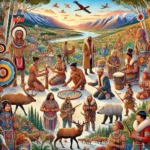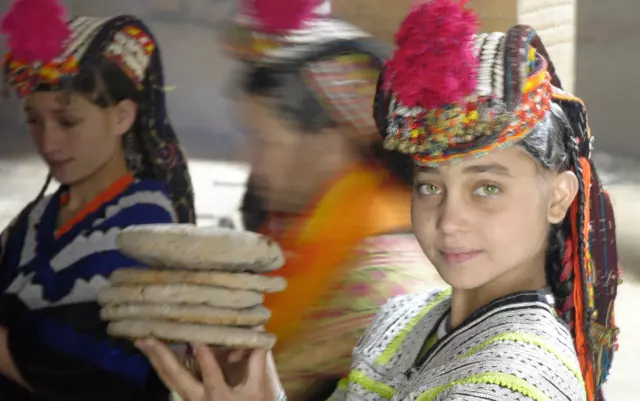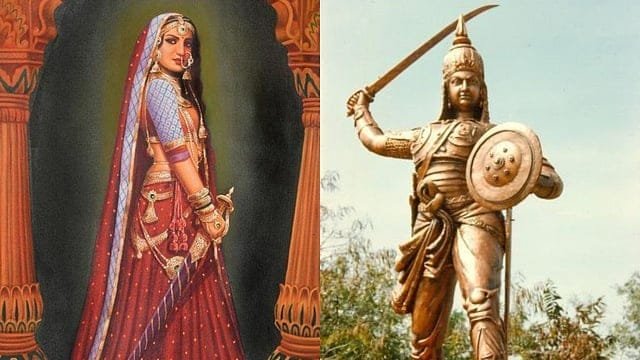The Kalasha (or Kalash) are a unique Dardic indigenous people residing in three remote valleys of the Hindu Kush mountains in Pakistan’s Khyber-Pakhtunkhwa province: Bumburet, Rumbur, and Birir. Often called “Pakistan’s Pagans,” they are renowned for their vibrant culture, ancient polytheistic religion, and distinct identity, which stands in stark contrast to the predominantly Muslim population surrounding them.
- Population
· Current Estimate: Approximately 3,000 to 4,000 people.
· Significance: This tiny number makes them one of the world’s smallest and most vulnerable indigenous minorities. Their population has been gradually declining relative to the growing Muslim population in and around their valleys.
- Culture
Kalasha culture is visually striking and deeply communal.
· Language: Kalasha-mondr, a Dardic language from the Indo-Aryan family. It is considered endangered.
· Dress: Women are famous for their colorful traditional dress: long black robes (piran), elaborate beaded headdresses (shushut), and shell necklaces. Their vibrant attire is a symbol of their identity.
· Festivals: Their calendar is marked by vibrant, music-filled festivals that are central to their social and religious life. The most famous are:
· Chilam Joshi (Spring Festival): Celebrates the arrival of spring and fertility.
· Uchau (Autumn Festival): Marks the harvest season with dancing and feasting.
· Chaumos (Winter Solstice Festival): The most important festival, a time of purification, celebration, and seeking blessings from the gods.
· Architecture: Their villages feature ornate wooden mosques and community halls (bashali), and traditional houses made of stone and wood.
· Social Structure: They are a egalitarian society with a strong emphasis on community decision-making.
- Religion
The Kalasha practice a form of ancient Indo-European polytheism, which is often considered a descendant of the ancient Vedic religion.
· Pantheon: They worship a pantheon of gods and goddesses. The supreme creator god is Dezau (or Khodai), while other important deities include Jestak (goddess of home, family, and hearth) and Balumain (a cultural hero god).
· Rituals & Purity: Their religion has complex concepts of purity (onjesta) and impurity (pragata). For example, women are considered pragata during menstruation and childbirth and retreat to a special communal building, the bashali, during this time.
· Shamans: Priests (dehar) and shamans act as intermediaries between the people and the gods.
- History & Origins
The origins of the Kalasha are a subject of debate and legend.
· Descendants of Alexander’s Army: The most popular theory, though historically unproven, is that they are descendants of soldiers from Alexander the Great’s army that invaded the region in the 4th century century BCE. Their European-like features (light skin, blue and green eyes) fuel this myth.
· Indigenous Indo-Aryan People: Scholars generally agree they are an indigenous tribe from the Nuristan region (in modern-day Afghanistan). They are culturally and linguistically linked to the Nuristani people, who were forcibly converted to Islam in the late 19th century.
· Forced Conversion: While their neighbors in Afghanistan were converted, the remote Kalasha valleys in Pakistan allowed their culture to survive, though not without pressure and gradual conversion over centuries.
- Threats to Their Existence
The Kalasha face a multitude of severe threats that endanger their survival.
· Forced Conversion: The most direct threat. Islamic missionaries are active in the valleys, and economic and social pressure often leads Kalasha, especially men, to convert to Islam. Conversion often means abandoning their unique cultural identity.
· Economic Pressures & Poverty: Widespread poverty drives young people to leave the valleys for cities to find work, where they assimilate into the mainstream culture. Many do not return.
· Cultural Dilution: The influx of tourists, while a source of income, often leads to commodification and a loss of cultural authenticity. Furthermore, exposure to mainstream Pakistani media and education erodes traditional values and language among the youth.
· Land Loss & Demographic Shift: Wealthier outsiders are buying land in the Kalasha valleys, gradually changing the demographic balance and pushing the indigenous people out.
· Natural Disasters: Their valleys are vulnerable to climate change-induced disasters like floods and landslides, which destroy homes and farmland.
- Work Being Done for Preservation
Several organizations and efforts are underway to protect the Kalasha and their heritage.
· Legal Protection: The Kalasha are granted special status by the Government of Pakistan, which officially recognizes their unique culture and provides some legal protection.
· NGO Efforts: Organizations like the Kalasha Peoples Development Network (KPDN) and international groups work on:
· Building sustainable tourism models that benefit the community directly.
· Setting up culturally-sensitive schools that teach both the Kalasha language and the standard Pakistani curriculum.
· Providing legal aid to prevent land grabbing.
· Running health clinics and other development projects.
· UNESCO Recognition: There have been ongoing efforts to have the Kalasha valleys inscribed as a UNESCO World Heritage Site to grant them international protection and recognition.
· Community Efforts: The Kalasha themselves are increasingly vocal, using social media and engaging with the government to advocate for their rights and preserve their traditions for future generations.
The Kalasha are a priceless living link to an ancient past. Their incredible cultural wealth stands on a precarious cliff, threatened by modernization, religious pressure, and economic hardship. While their future is uncertain, a combination of local resilience, national protection, and international support offers a glimmer of hope that this beautiful and ancient tribe can be saved from extinction.












